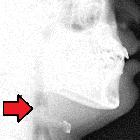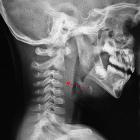Epiglottitis














Epiglottitis, also known as supraglottitis, is a life-threatening condition caused by inflammation of the epiglottis and aryepiglottic folds , which can lead to acute airway obstruction.
Epidemiology
The traditional age of presentation is in children of 3 to 6 years, although this has been changing due to the routine vaccination against Haemophilus influenzae type B (Hib) introduced in most countries. Epiglottitis has had a decreasing incidence since the introduction of Hib vaccinations.
Pathology
Etiology
Hib used to be the most common responsible organism but group A beta-hemolytic Streptococci is becoming more common due to Hib vaccinations .
Causes of epiglottitis include inflammatory and infective, including atypical infections such as TB.
Epiglottitis can be caused by direct extension of infection from other adjacent head and neck regions, such as dental infection, tonsillitis, laryngopyocoele and skin cellulitis .
Inflammatory causes include sarcoidosis. Sarcoidosis associated epiglottitis is usually limited to the supraglottic larynx with sparing of the true vocal cords (as they have a sparse lymphatic system).
Clinical presentation
The presentation has a very rapid course beginning with a sore throat and leading to difficulty swallowing and drooling. However, other presenting symptoms include:
- fever
- difficulty speaking
- muffling or changes in the voice
- inspiratory stridor
- severe dysphagia
Acute epiglottitis is potentially life threatening due to the risk of airway obstruction, particularly in children. The adult form tends to have a lower risk of airway obstruction due to the larger size of the adult airway and better tolerance of supraglottic edema .
Radiographic features
Plain radiograph
Lateral soft tissue radiograph of the neck demonstrates thickening of the epiglottis and aryepiglottic folds referred to as the thumb sign.
It should be noted that an omega epiglottis, either a variant of normal or in the setting of laryngomalacia, can result in a similar appearance and can be mistaken for epiglottitis.
In epiglottitis, the hypopharynx may be over-distended.
CT
CT is only rarely obtained, and usually when the diagnosis is unclear. Indeed, placing the child in the supine position can actually precipitate respiratory arrest. If a scan is obtained, marked edema and thickening of the epiglottis and aryepiglottic folds may be seen with narrowing of the airway.
Treatment and prognosis
Treatment must be expeditious given the life-threatening nature of the condition:
- patients should be kept upright in a comfortable position
- airway management with oxygen therapy
- early tracheal intubation by specialist staff: if ET tube placement is impossible because of an inflamed epiglottis, emergency needle cricotracheostomy may need to be performed
- IV fluids
- IV steroids and antibiotics
Differential diagnoses
- croup (laryngotracheobronchitis)
- subglottic narrowing and ballooning of hypopharynx
- no epiglottis thickening
- inhaled foreign bodies
- pharyngitis
- pneumonia
- peritonsillar abscess
- retropharyngeal abscess
- usually clinical following tonsillitis
- bacterial tracheitis
- asymmetric subglottic narrowing (intraluminal membranes)
- all causes of epiglottic enlargement
Siehe auch:
und weiter:

 Assoziationen und Differentialdiagnosen zu Epiglottitis:
Assoziationen und Differentialdiagnosen zu Epiglottitis:


